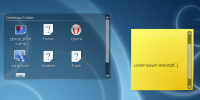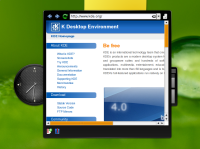came back from akademy saturday by plane together with Ruphy, WindowsUninstall and Andjam, all gone smooth, unlike other people, sorry guys 🙁 apart from the fact i now have a spectacular cold (probably weather nicer than the belgian one was a too big shock :))
don’t know what to say about it in particular, apart that KDE people are really amazing, especially those people have done a really crazy job, there was a sense of world domination really fantastic, it makes feel that is actually possible (hmm, maybe not world domination, but at least market domination yeah:).
Now at home, have a couple of patches still in the laptop that should really be polished/committed or mercilessy thrown away (/me laaazy)
Most important i should really do my thesis, and i’m trying really hard to do it (now i’m in the phase of making old terrible code to look good ohyeah, funny as eating a bunch of nails:)
But really nicer things pops up, like uhm… installing KDE4 on the new shiny n810 (Sorry for everybody else, but i’m reeally happy it did come with an Italian type L power plug eheheh) 😛
These are some reeeally empirical advices i’ve got, btw the Mek’s guide should be mostly enough:
- Space on main device storage it’s negligible, just compile with a prefix under /media/mmc1 or /media/mmc2, maybe even qt
- If you like me are a bit autolesionist, installing on vfat does work, just copy dereferencing the links with cp -R -L, would eat way more disk space but yay, works!
- internal or external memory cards are mounted with noexec flag by default, so before starting it go into root (r&d mode must be enabled) unmount and mount them again
- Installing dependencies and compiling qt+kde under scratchbox eats an humongous quantity of disk space, be prepared to sacrify around 10+ gigs of hard drive space 🙂
- as Mek said if you got a compilation problem good odds that is qdbuscpp2xml (qt bug?), so delete the 0 bytes generated xml file, make with VERBOSE=1 to see the exact command and generate that file again with the system’s qdbuscpp2xml outside scratchbox
- maybe it’s just here, but sometimes seems to really hate make -jsomething, even if you have a garzillion of cores better you forget it when you compile kdelibs under scratchbox
- most of dependencies can be downloaded with apt, except shared-mime-info that the provided one is freakin’ ancient, oh and boost (ouch!) if you want kdepimlibs, but till didn’t managed to get pimlibs compile
Random impressions:
Very nice device, love its openess (well at least of the software) and hackability, it’s nearly not marketed at all and way too expensive, otherwise would sell many times it sells(or rather not sell) now
Little roadblock between us and world conquering: QGraphicsProxyWidgets seems to not accept some keyboard input: letters don’t work, enter and control shortcuts work, it’s in this way i managed to post from twitter applet (qt or hildon input methods bug?)
Oxygen widgets on one hand looks really nice due to the really high number of dpi, on the other hand gradients looks way crippled by the 16bit color depth
Overall is slow but not so much, some applications react to the tiny screen size better than one would imagine, plasmoids are in general behaving well, apart the input problem, /me thinks having a plasma interface designed for this type of beasts won’t be too hard.








 Just made plasma tooltips to look like this. Oh btw, the artworks are still temporary 🙂
Just made plasma tooltips to look like this. Oh btw, the artworks are still temporary 🙂